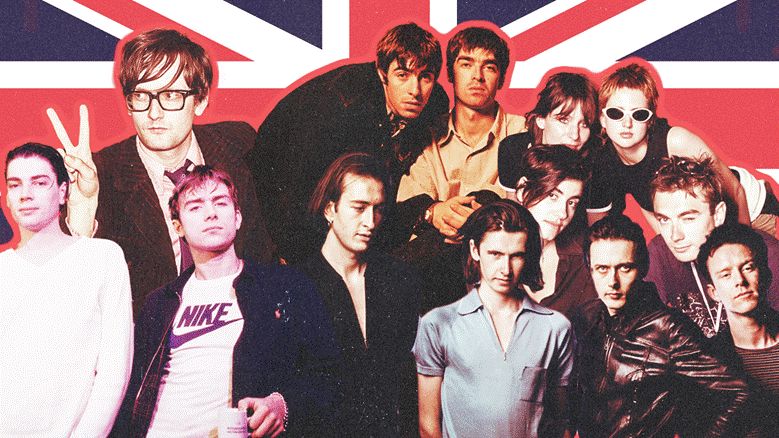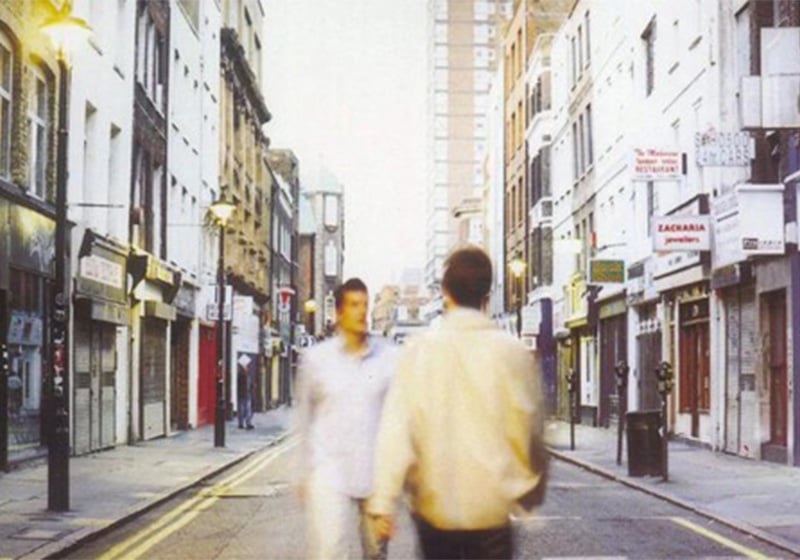Table of Contents
Some things will be forever associated with nineties culture: the sound of dial-up modems, Disney’s string of blockbusters, sitcoms like Friends and The Simpsons, grunge, the first PlayStation and… Britpop!
This musical and cultural phenomenon might have peaked in the mid-nineties, but its anthems still move people to this day. And not just Millennials and Gen Xers nostalgic for their youth. In the summer of 2025 Oasis – the band that became synonymous with the movement, together with Blur, The Verve and Pulp – filled stadiums with fans old and new as they embarked on a marathon world tour, the group’s notoriously fractious founding brothers, Noel and Liam Gallagher, having kissed and made up.
When we think of catchy nineties rock from Blighty, a series of images streams through our minds. And perhaps the most symbolic is the cover to a seminal album.

(What’s the story) Morning Glory, Oasis’s second album, was released on 2 October 1995 by indie label Creation Records. It fast became the band’s – and Britpop’s – biggest-selling album, with 22 million copies sold in total. As well as featuring classics like “Wonderwall”, “Don’t Look Back in Anger” and “Champagne Supernova”, the album carried an enigmatic cover: a blurry photo of two men striding towards each other on a typical British street.
The (What’s the story) Morning Glory cover belongs in the pantheon of great album art. And because the Gallagher brothers are involved, amusing anecdotes abound about its making. Today, we’re going to find out who made this emblematic image and what happened during the photoshoot…
Lots of questions, few answers. The idea behind the (What’s the story) Morning Glory cover
Two men crossing paths on a street, early on a Sunday morning. Where is this street? Who are these men? Are they looking at one another? Are they stopping to say hello, or each ignoring the other? Are they talking? What are they saying?
When we turn over the album, on the back we see just one of these men. The other has vanished into thin air. This sense of time standing still is what makes the cover so intriguing – and so beloved by fans.

The cover to (What’s the story) Morning Glory by Oasis. Image: amazon.it
It is the many questions of our time (or at least the nineties) – and the few answers we have – that inspired this art. So says Brian Cannon – the creator of this Oasis cover and many more besides – who recalls an observation Noel Gallagher made at the time: there aren’t ever answers; there are only ever more questions.
Other inspirations include the cover to The Freewheelin’ Bob Dylan [which we talked about here], released 30 years earlier, and Wish You Were Here by Pink Floyd, which also has two mysterious men on the front.

While the meaning behind the (What’s the story) Morning Glory cover remains something of a mystery, we know more about the entertaining story of its making.
How the (What’s the story) Morning Glory album cover was made
The (What’s the story) Morning Glory album cover is the work of Brian Cannon, the photographer and designer who, after first working with The Verve, went on to create some of Oasis’s most famous record covers. Yet it wasn’t Cannon who snapped the shot, but his collaborator, Michael Spencer Jones. Why? Because Cannon had to pose for the photo – he’s the man in the beige jacket, walking away from the camera!

Originally, the Gallagher brothers were meant to appear on the cover to (What’s the story) Morning Glory, but things didn’t quite go to plan…
And this is where accounts start to get confusing and contradictory: as Cannon tells it, because the shot had to be taken first thing in the morning, the crew for the shoot – plus Liam and Noel – decided to go out the evening before and simply stay up all night. But the Gallaghers had one too many, and were in no state to participate. Others say that Noel had a stomach upset, while others claim that Liam and Noel were not actually supposed to be there as they were on tour at the time. Wherever the truth lies, everyone agrees on one thing: Noel and Liam Gallagher did not take part in the photoshoot for (What’s the Story) Morning Glory.
The second person pictured on the cover is the DJ Sean Rowley, friend of the band and “survivor” of the bender the night before the shoot.

But there’s actually a third man on the (What’s the story) Morning Glory cover. Look closely and in the background you’ll notice a man holding a white record aloft. That man is Owen Morris, the album’s producer, and in his hand is the freshly pressed master for the record. Legend has it that Morris carried the LP around with him everywhere he went the night before, nearly losing it on more than one occasion!
Berwick Street, London: the Soho street where the (What’s the story) Morning Glory cover photo was shot.

There are many unknowns about this album photo, but what we do know is where it was taken: Berwick Street, in London’s Soho, renowned for its record shops at the time.
What’s more, at the spot where the photo was shot, Berwick Street meets… Noel Street. Something that must surely have tickled the band leader’s ego. Berwick Street is also famous for its colourful fruit and veg market (held in the street for almost 200 years). This made it tricky to find a time when the street was empty. That’s why the crew shot the photo at dawn on a Sunday – 23 July 1995, to be precise – wrapping things up after a couple of hours’ shooting

Funnily enough, the photo picked for the cover was the very first taken. “We could have just gone back to the pub,” Brian Cannon later pointed out, but given that he still used an analogue camera at the time, it wasn’t until he developed the film the next day that he realised the first shot was the best.
These days, the street where the (What’s the Story) Morning Glory cover photo was shot is a mecca for Oasis fans and Britpop nostalgics, while online there are all manner of memes, spoofs and mash-ups of the iconic image.

What do you think about the legendary album cover for (What’s the story) Morning Glory? Are you a fan? Does it bring back memories? And what do you think about the typically Britpop way it was made?

